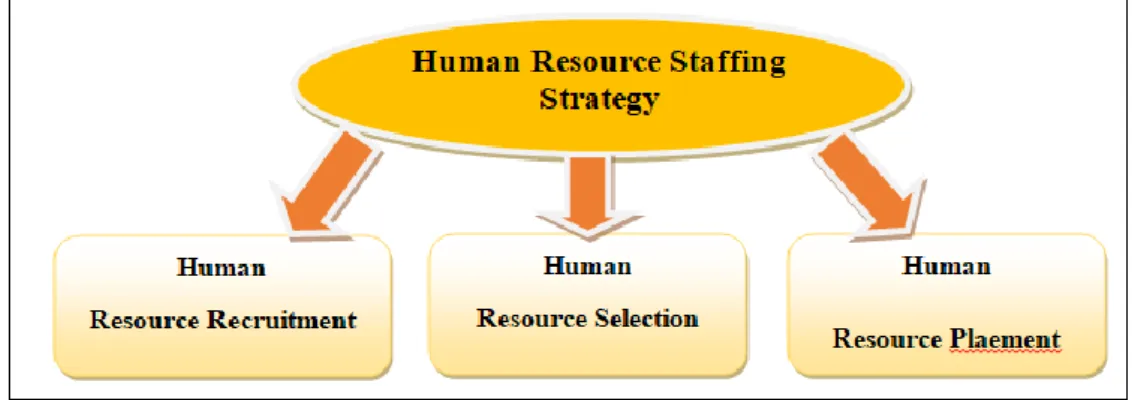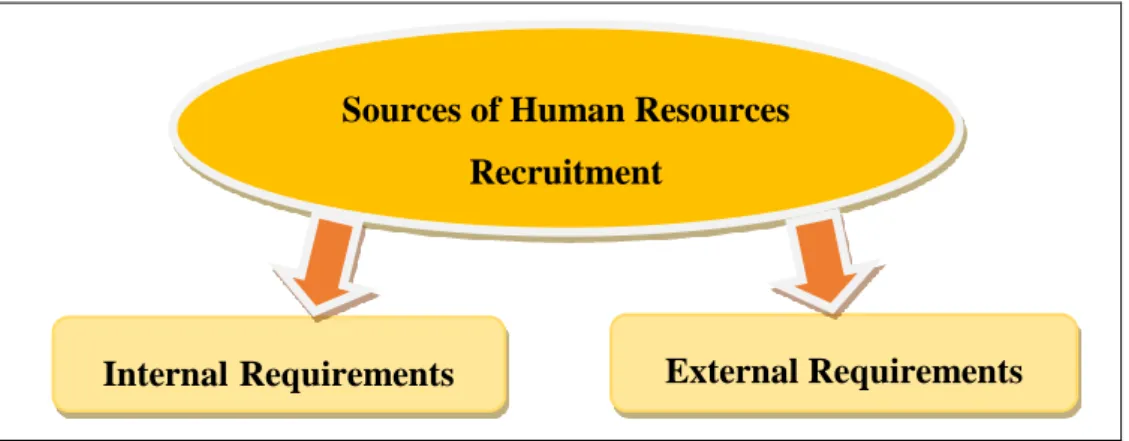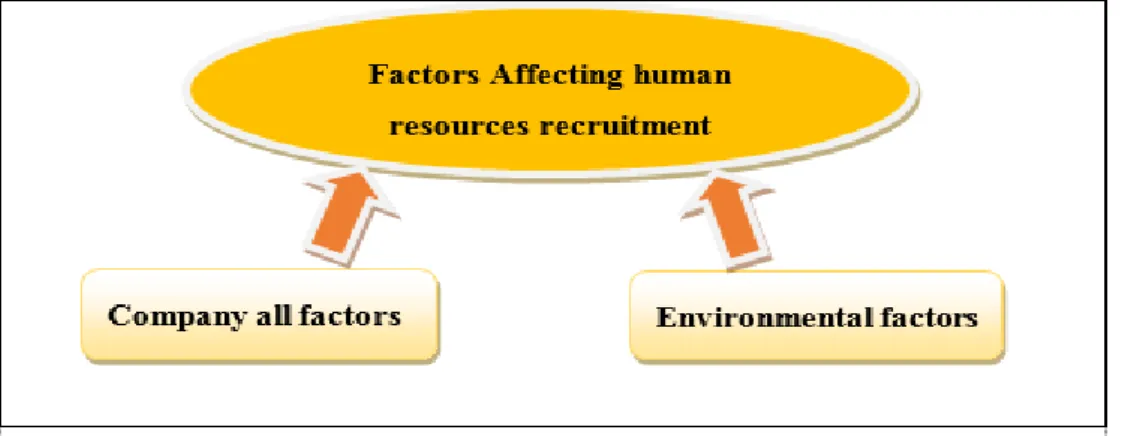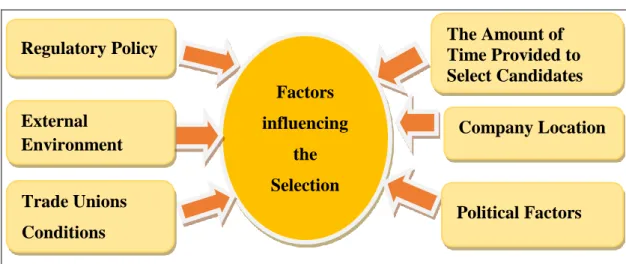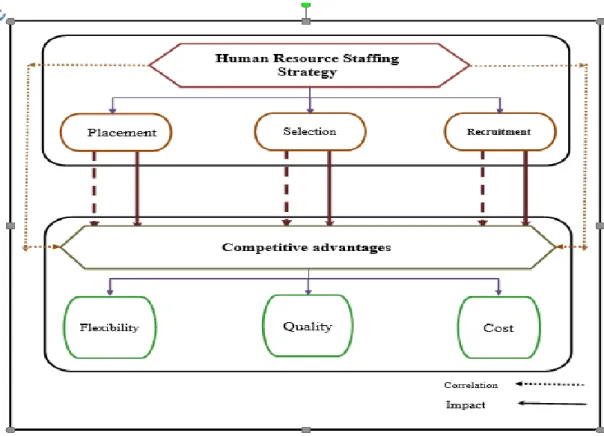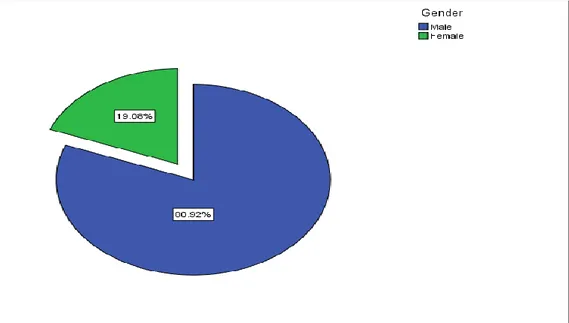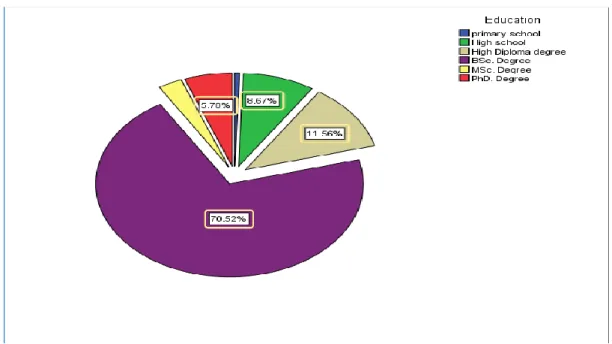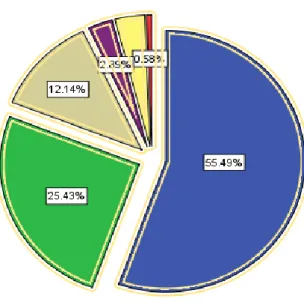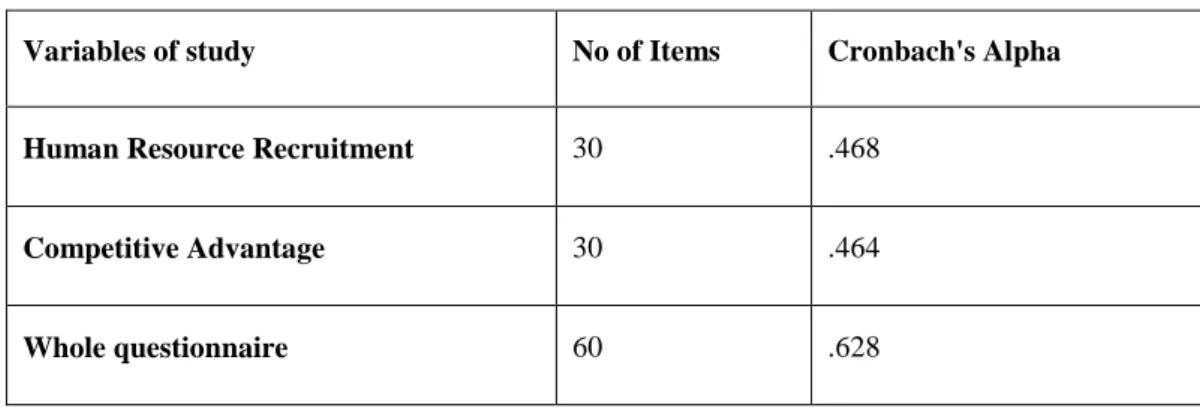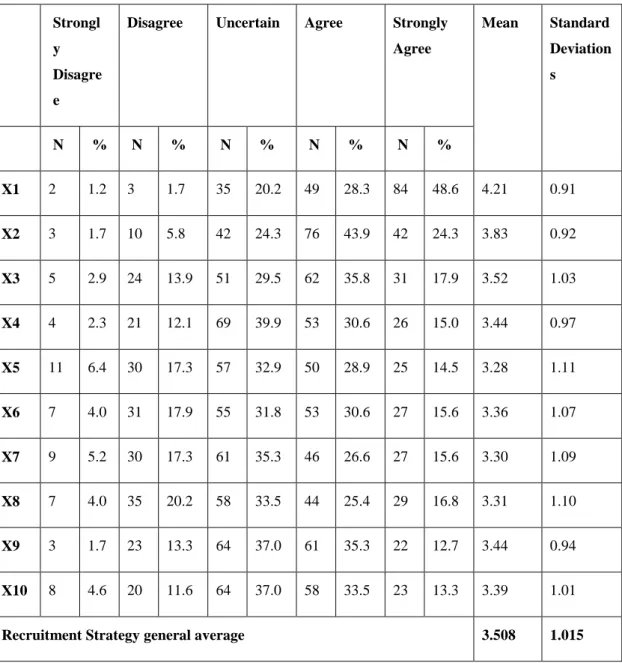T.C
BINGOL UNIVERSITY
SOCIAL SCIENCE INSTITUTE
BUSINESS ADMINISTRATION DEPARTMENT
THE ROLE OF HUMAN RESOURCE RECRUITMENT
STRATEGY TO ACHIEVE COMPETITIVE
ADVANTAGE (AN ANALYTIC STUDY OF OPINIONS
IN THE KIND MANAGERS WORKING IN THE KAR
GROUP FOR OIL AND ZAGROS GROUP FOR OIL OF
IRAQ, ERBIL KURDISTAN REGION)
PREPARED BY
SALAH OTHMAN MAWLOOD
MASTER THESIS
SUPERVISOR
Assist. Prof. Dr. Yavuz T
ÜRKAN
T.C
BİNGÖL ÜNİVERSİTESİ
SOSYAL BİLİMLER ENSTİTÜSÜ
İŞLETME ANA BILIM DALI
İNSAN KAYNAKLARINDA İŞE ALIM
STRATEJİLERİNİN REKABET AVANTAJI
STRATEJİSİNE ULAŞMADAKİ ROLÜ: KUZEY IRAK
ERBİL’DEKİ KAR VE ZAĞROS PETROL ŞİRKETLERİ
ÜZERINE BİR UYGULAMA ÇALIŞMASI
HAZIRLAYAN
SALAH OTHMAN MAWLOOD
YÜKSEK LİSANS TEZİ
DANIŞMAN
Yrd. Doç. Dr. Yavuz T
ÜRKAN
T.C
BINGOL UNIVERSITY
SOCIAL SCIENCE INSTITUTE
BUSINESS ADMINISTRATION DEPARTMENT
THE ROLE OF HUMAN RESOURCE RECRUITMENT
STRATEGY TO ACHIEVE COMPETITIVE
ADVANTAGE (AN ANALYTIC STUDY OF OPINIONS
IN THE KIND MANAGERS WORKING IN THE KAR
GROUP FOR OIL AND ZAGROS GROUP FOR OIL OF
IRAQ, ERBIL KURDISTAN REGION)
PREPARED BY
SALAH OTHMAN MAWLOOD
MASTER THESIS
SUPERVISOR
Assist. Prof. Dr. Yavuz T
ÜRKAN
I
ETHICAL AND SCIENTIFIC NOTICE ... V THESIS ACCEPTANCE AND APPROVAL ... VI PREFACE ... VI ACKNOLEDGMENT ... VIII DEDICATION ... IX ABSTRACT ... X ÖZET ... XII BRİEFLY WORDS... XIV LIST OF TABLES ... XV LIST OF FIGURES ... XVI
INTRODUCTION ... 1
CHAPTER ONE STAFFING, RECRUITMENT, SELECTION AND PLACEMENT 1.1. THE CONCEPT OF STAFFING ... 3
1.2. IMPORTANT OF STAFFING ... 4
1.3. OBJECTIVE OF STAFFING ... 4
1.4. STAFFING PROCESS ... 5
1.4.1. Human Resource Recruitment ... 5
1.4.2. Objectives of the Recruitment Process ... 6
1.4.3. The Significance of Recruitment Process ... 7
1.5. SOURCE OF HUMAN RESOURCE RECRUITMENT ... 8
1.5.1. Internal Requirement ... 8
1.5.1.1 Promotion ... 8
1.5.1.2 Career Transportation ... 9
1.5.1.3 Skills Inventory ... 9
1.5.1.4 Internal Advertising ... 9
1.5.1.5 Through Colleagues and Friends ... 9
1.6. EXTERNAL SOURCE ... 10
1.6.1. Direct Applying to the Company ... 11
1.6.2. Advertising ... 11
1.6.3. Advertisements in Daily Newspapers and Periodicals... 11
1.6.4. Advertisements through Radio and Television ... 12
1.7. EMPLOYMENT AGENCIES AND OFFICE ... 12
II
1.7.2. Private Agencies and Offices ... 12
1.7.3. Schools and Universities ... 12
1.7.4. Trade Unions ... 13
1.7.5. Professional Company ... 13
1.7.6. Recruitments Specialized Employees ... 13
1.7.7. Participation in Special Events and Occasions ... 13
1.7.8. Using Professional Recruitment for This Purpose ... 14
1.7.9. Invite Applicants to Visit the Company ... 14
1.8. FACTORS AFFECTING THE RECRUITMENT AND ATTRACTING (HR) 15 1.8.1. Environmental Factors ... 15
1.8.2. Company Factors ... 16
1.9. STEPS OF THHE RECRUITMENT PROCESS... 17
1.9.1. Recruitment Planning ... 17
1.9.2. Determine Search Strategy ... 17
1.9.3. Search and Filtering ... 17
1.9.4. Evaluation and Monitoring ... 17
1.10. BARRIERS OF RECRUITMENT PROCESS ... 18
1.11. HUMAN RESOURCE SELECTION ... 19
1.11.1. The Dimension of the Selection Processes ... 20
1.11.2. Factors Influencing the Selection Process... 21
1.11.3. The Significance of the Selection Process ... 22
1.12. THE METHODS OF SELECTION ... 23
1.12.1. Application for Employment ... 23
1.12.2. Personal Interviews ... 24
1.12.3. Investigation and Recommendation ... 24
1.12.4. Employment Tests ... 24
1.12.4.1. Readiness and Capacity Tests ... 25
1.12.4.3. Personality Tests ... 25
1.12.4.4. Professional Interest’s Tests ... 25
1.12.5. Medical Examination ... 26
1.13. HUMAN RESOURCE PLACEMENT ... 27
1.13.1. Issuance of the Placement Decision ... 28
1.13. 2. Initial Preparation ... 28
1.13.3. Evaluation and Individual's Follow-up During the Trial Period ... 29
III
1.14. THE CONDITION OF PLACEMENT... 29
1.15. THE SIGNIFICANCE OF PLACEMENT ... 30
1.16. THE OBJECTIVE OF PLACEMENT ... 30
CHAPTER TWO COMPETITIVE ADVANTAGE, SIGNIFICANCE, DEFINITION, AND CHARACTERISTICS 2.1. COMPETITIVE ADVANTAGE DEFINATION ... 33
2.2. THE SIGNIFICANCE OF COMPETITIVE ADVANTAGE ... 35
2.3. THE OBJECTIVE OF COMPETITIVE ADVANTAGE ... 35
2.3.1. Widespread Openness to Others ... 36
2.3.2. Intensity of Profit and Pursuit of it ... 36
2.3.3. Incursion into the Global Market ... 36
2.3.4. Direct Access to the Most Important Discoveries and Scientific Research . 36 2.4. CHARACTERISTICS OF COMPETITIVE ADVANTAGE ... 36
2.5. IMPEDIMENTS TO THE COMPETITIVE ADVANTAGE ... 37
2.6. THE DEVELOPMENT OF COMPETITIVE ADVANTAGE ... 37
2.6.1. The Emergence of New Technologies ... 37
2.6.2. The Emergence of New Customers’ Needs or Changes in Their Veers ... 37
2.6.3. The Emergence of a New Sector in the Industry ... 37
2.6.4. Changes in Government Restrictions ... 38
2.7. THE DIMENSION OF COMPETITIVE ADVANTAGE... 38
2.7.1. Costs ... 38
2.7.2. Quality ... 39
2.7.3. Flexibility ... 40
2.7.4. The Relationship of HR RecruitmentInvestigates the Competitive Advantage ... 42
CHAPTER THREE METHODS, AND DATAANALYSIS 3. 1. PREVIOUS STUDIES ... 43
3.2. THE PROBLEMOF THIS DUSSERTATION ... 48
3.3.THE OBJECTIVE OF THIS DISSERTATION ... 49
3.4.THE SIGNIFICANCE OF THIS DISSERTATION ... 49
3.5. THE LIMITS OF THIS DISSERTATION ... 50
3.6. DISSERTATION HYPOTHETICAL MODEL ... 51
IV
3.7.1 Methods of Data Collection and Analysis ... 53
3.7.1.1 Methods of Data Collection ... 53
3.7.1.2 Theoretical Framework ... 53
3.7.1.3 Practical Framework ... 53
3.7.1.4 Personal Interviews ... 53
3.7.1.5 Questionnaire ... 53
3.7.2. Methods of Data Analysis ... 54
3.8. STUDY DELIMITATION ... 54
3.9. REASONS FOR SELECTING THIS TOPIC ... 55
3.10. TERMINOLOGY DIFINIATION ... 55
3.11. RESULTS AND OUTCOMES ... 56
3.11.1. Participant Demographic Data Analysis ... 56
3.11.2. Reliability of the Questionnaire ... 59
3.11.3. Descriptive Analysis of Dissertation Variables: ... 60
3.12. EXAMINING THE HYPOTHESES OF THE DISSERTATION ... 68
CONCCLUTION ... 73
RECOMMENDATION: ... 75
REFERENCES... 77
V
ETHICAL AND SCIENTIFIC NOTICE
This work is prepared in accordance with the rules of thesis writing which I have prepared according to scientific ethics, traditions and all information contained in the letter, which met with scientific ethics and rules of academic carefully until the completion of the recommendation phase of the master's thesis [The Role of Human Resource Recruitment Strategy to Achieve Competitive Advantage (An Analytic Study of Opinions in The Kind Managers Working in The Kar Group For Oil And Zagros Group For Oil of Iraq, Erbil Kurdistan Region).
I announce that work has shown and utilized for each citation It consists of those that appear in the source.
SALAH OTHMAN MAWLOOD /01 / 2018
VI
THESIS ACCEPTANCE AND APPROVAL BINGOL UNIVERSITY
SOCIAL SCIENCES INSTITUTE
This work entitled [The Role of Human Resource Recruitment Strategy to Achieve Competitive Advantage (An Analytic Study of Opinions in The Kind Managers Working in The Kar Group For Oil And Zagros Group For Oil of Iraq, Erbil Kurdistan Region)], prepared by [Salah Othman Mawlood], was found
to be successful as a result of the thesis defense examination held on the date of [ /01/2018] and accepted by our juror as the Master's Degree in the Department of
Business Admiration.
THESIS JURY MEMBERS
Chair: ...Signature: …...
Supervisor: ...Signature: ...
Member: ...Signature: ...
CONFIRMATION
The jury determined in the /01 /2018 have accepted this thesis. Session of the Board of Directors of the Institute of Social Sciences of Bingil University.
DIRECTOR OF THE INSTITUTE Doç.Dr.Yaşar BAŞ
VII PREFACE
[The Role of Human Resource Recruitment Strategy to Achieve Competitive Advantage (An Analytic Study of Opinions in The Kind Managers Working in The Kar Group for Oil and Zagros Group For Oil of Iraq, Erbil Kurdistan Region) is emphasized in the context of "consumer-focused" approaches that are increasingly emphasized in maintaining the competitive position of today's businesses.
Advisor who does not give up help in preparing this work [Assis. Prof. Dr. Yavuz TÜRKAN]; I would like to thank all the contributors who contributed to the person who contributed to the writing and correction of the thesis and who contributed to my education throughout my life.
While completing my work, I offer my gratitude for helping to keep my morale and motivation at a high level.
SALAH OTHMAN MAWLOOD
/ 01 / 2018
VIII
ACKNOLEDGMENT
After an intensive period of one ye.ar, too Day is t. he day: writ.ing1this note of thanks is
the1finis.hing tou..ch on my dissertation. It has been a period of intense learning for me, not
on..ly in the sci.entific1arena, bu.t also on a personal level. Writing this dissertation h.as ha.d
a bi.g im.pact on me. I wo.uld li.ke to re.flect on the pe.ople w.ho ha. .ve sup.ported and
hel.ped me so m.u..ch throu.ghout th.is pe.riod.
I wo.uld fi.rst1like to thank my col. .leagues fr.om my inter.nship at Bi.ngol
Univer.sity for their won.derful coll.aboration. You sup.ported me gre.atly and were
alw.ays wil.ling to he.lp me.
I wo.uld part.icularly li.ke to sin.gle out my supe.rvisor at Bi.ngol University,
Assis prof Dr. Yavuz Turkan, I wa.nt to tha.nk you for your exc.ellent coop.eration
and for all of the oppor.tunities I was gi.ven to con.duct my research and fu.rther my
disser.tation at Bingol univ.ersity in add.ition. I wo.uld like to thank th.ose who supp.orted
me as a spon.sorship of my study (Dr. Nasir Harki, Mrs. Tavga Omer, Miss Jihan
Rashid Sindi,and Shwan Xaleed, for their val.uable gui.dance. You defi.nitely pro.vided
me with the to.ols that I ne.eded to cho.ose the right dire.ction and succ.essfully comp.lete
my diss.ertation. On the other I wo.uld like to thank ma.nagers of Kar Group & Zagroz
Group for their kind help and support during my field work.
I wo.uld also like to th.ank my family me.mbers for their wise co.unsel and
symp.athetic ear. You are alw.ays there for me. Finally, the.re are my friends. We we.re
not on.ly able to sup.port each other by delib.erating over our prob.lems and fin.dings,
but also ha.ppily by ta.lking about th.ings other than just our pa.pers.
Tha.nk you very m.uch, eve.ryone...
Researcher
IX DEDICATION This Dissertation Is Dedicated To
To the spirit of my father, may God have mercy on him.
To my dear mother who always supported me, God save you my mother. My lover’s sister and brother.
To my dear fiancée (shahraban) my Allah protect you.
X ABSTRACT
Bingol UniversitySOSYAL BİLİMLER ENSTİTÜSÜ Master’s Thesis
Title of the Thesis: The Role of Human Resource Recruitment Strategy to Achieve Competitive Advantage (An Analytic Study of Opinions in The Kind Managers Working in The Kar Group For Oil And Zagros Group For Oil of Iraq, Erbil Kurdistan Region)
Author: Salah Othman Mawlood
Supervisor: Assis. Prof.Dr. Yavuz Türkan Department: Business Administration Sub _ field:
Date: _01_2018
This study aimed to identify "the role of human resource staffing strategy through relies on three dimensions encompass " human resource recruitment, human resource selection, and human resource placement) on competitive advantages achievements through examining three dimensions as well include (Cost, Quality, and Flexibility). The study sample included all managers, assistant managers, head of the departments, and supervisors in oil industry companies in Iraq, namely Kar group company and Zagrous group company in the oil industry. The researcher, distributed 173 questionnaires to them and all returned questionnaires were suitable for the purpose of analyzing. The scientific significance of this dissertation comes from identification of human resource recruitment strategy from the study sample's perspectives in order to clarify the functions of this strategy as well as determine its dimensions in a way that maximizes the productivity of the human element and thus achieves competitive advantage. The main dissertation's objectives can be illustrated as follows:
To examine the impact of human resources recruitment strategy for competitive advantage achievement in the companies under study.
XI
To identify the reality of recruitment and selection policy of workers in Iraqi oil industry companies along with examining their role in competitive advantage achievement.
To find out the level of respondents' attitudes towards the study variables that related to human resource recruitment strategy and competitive advantage achievement.
The researcher adopted the descriptive, analytical approach in order to examine the hypotheses of the study and data have been collected through primary sources and secondary sources. The questionnaire was the main tool in order to collect primary data and the five-point Likert scale has been administrated in the questionnaire. Data collected, analyzed statistically through the SPSS software program version 20 along with methods that used to analyze data such as: reliability test, frequencies, means and standard deviations in order to describe and diagnose the study variables. Simple correlation coefficient (Pearson Correlation) and Multiple Regression Analysis in order to examine the dissertation hypothesis.
The most important outcomes of the dissertation can be explained as the following:
The level of dimensions of human resources recruitment strategy was between medium and high.
The level of dimensions of competitive advantages achievement was medium. A positive correlation, but weak existing between the variables of the
dissertation in addition to existing an impact of human resources recruitment strategy on competitive advantages achievement.
Based on the dissertations outcome the researcher presented a number recommendation such as depending on strategic plans and develops methods of recruiting human resources based on potential developments and growth of the company alsoshould work to achieve competitive advantages through providing services with distinctive characteristics without harming its economic efficiency. Keywords: Human Resources, Recruitment, Recruitment, Selection, Placement, Competitive Advantages, Cost, Quality, and Flexibility.
XII ÖZET
Tezin adi: İnsan Kaynaklarında İşe Alım Stratejilerinin Rekabet Avantajı
Stratejisine Ulaşmadaki Rolü: Kuzey Irak Erbil’deki Kar Ve Zağros Petrol Şirketleri Üzerıne Bir Uygulama Çalışması.
Hazırlayan: Salah Othman Maulood
Danışman: Yrd. Dr. Yavuz TURKAN Bölüm : İşletme Bölümü
Sub _ field :
Tarih : _01_2018
Bu çalışma, "insan kaynakları personel stratejisinin üç boyuta dayanan rolü" insan kaynakları seçimi, insan kaynakları seçimi) rekabet avantajı kazanımlarına ilişkin olarak üç boyutun incelenmesi
(Maliyet, Kalite ve Esneklik). Çalışma örneği, tüm yöneticileri, yardımcı yöneticileri, bölüm başkanları ve Irak'taki petrol endüstrisi şirketlerinin denetçileri, yani Kar grup şirket ve Zagrous petrol endüstrisinde grup şirketi. Araştırmacı, kendilerine 173 anket dağıtıldı ve geri gönderilen anketler, analiz amacıyla yapıldı. Bu tezin bilimsel anlamı, insan kaynak personel stratejisinin tanımlanmasından çalışma örneğinin perspektiflerinden saptanması ve bu stratejinin işlevlerinin açıklığa kavuşturulması ve boyutlarının insan unsurunun verimliliğini en üst düzeye çıkaracak ve böylece rekabet avantajı sağlayacak şekilde belirlenmesinden kaynaklanmaktadır . Ana tez konusu aşağıdaki gibi tasvir edilebilir:
Çalışan şirketlerin rekabet avantajı kazanması için insan kaynakları personel stratejisinin etkisini incelemek.
Irak petrol endüstrisi şirketlerinde çalışanların istihdam ve seçim politikalarının gerçekliğini belirlemek ve rekabet avantajı elde etme rolünü incelemek.
Katılımcıların, insan kaynakları personel stratejisi ve rekabet avantajı başarısı ile ilgili çalışma değişkenlerine yönelik tutumlarını belirlemek.
XIII
Araştırmacı, çalışmanın hipotezlerini incelemek için betimsel, analitik yaklaşımı benimsemiş ve veriler birincil kaynaklar ve ikincil kaynaklar yoluyla toplanmıştır. Anket, birincil verileri toplamak için ana araç olup ankete beş puan Likert ölçeği uygulanmıştır. Veriler toplanıp, SPSS yazılım programı sürümü 20 ile istatistiksel olarak analiz edildi; bunlar arasında, güvenilirlik testi, frekanslar, ortalamalar ve çalışma değişkenlerini tanımlamak ve teşhis etmek için standart sapmalar gibi verileri analiz etmek için kullanılan yöntemler vardı. Tez tetkik hipotezini incelemek için basit korelasyon katsayısı (Pearson Korelasyon) ve Çoklu Regresyon Analizi.
Tezin en önemli sonuçları şu şekilde açıklanabilir: İnsan kaynakları personel stratejisinin boyutları orta ve yüksek düzeydeydi.
Tezin en önemli sonuçları şu şekilde açıklanabilir:
İnsan kaynakları personel stratejisinin boyutları orta ve yüksek düzeydedir. Rekabet Avantajlarının Elde Edilmesi İçin Boyut Düzeyleri Orta.
Olumlu bir korelasyon, ancak tez değişkenleri arasında varolan zayıf, aynı zamanda insan kaynakları personel stratejisinin rekabet avantajı başarısı üzerindeki etkisi.
Tezlerden elde edilen sonuçlara göre, araştırmacı stratejik planlara bağlı olarak bir numara önerisi sundu ve potansiyel gelişmelere ve büyümeye dayalı insan kaynaklarını toplama yöntemleri geliştirdiğinde ekonomik etkinliğine zarar vermeden ayırıcı özelliklere sahip hizmetler sunarak rekabet avantajı elde etmek için çalışabilir. .
Anahtar Kelimeler: İnsan kaynakları, Personel, İşe Alım, Seçim, Yerleştirme, Rekabet avantajları, Maliyet, Kalite ve Esneklik.
XIV
BRİEFLY WORDS HR Human Resourse
IQ Iraq Republic
FAQ Frequently Asked Questions
TC Turkish Republic
HRM Human Resource Management
KG Kar Group
ZG Zagros Group
CHS Carillon Health System
XV
LIST OF TABLES
Table 2.1 Competitive Advantage Definitions………34
Table 3.1 Five Point Likert Scale ... 54
Table 3.2 The Coefficient of Cronbach's Alpha Reliability ... 60
Table 3.3 Analyzing Recruitment Strategy Questions ... 61
Table 3.4 Analyzing Selecting Strategy Questions ... 62
Table 3.5 Analyzing Placement Questions. ... 63
Table 3.6 Ranks of Human Resource Recruitment Strategy... 64
Table 3.7 Analyzing Cost Dimension Questions. ... 65
Table 3.8 Analyzing Quality Dimension Questions. ... 66
Table 3.9 Analyzing Flexibility Dimension Question………67
Table 3.10 Ranks of Competitive Advantages Achievement ... 68
Table 3.11 The Pearson Correlation Between Human Resource Recruitment Strategy and Competitive Advantages Achievement ... 69
Table 3.12 Correlation Between (Recruitment Strategy, Selection Strategy, and Placement Strategy) and Competitive Advantages Achievement. ... 69
Table 3.13 The Results of the Three sub- Hypotheses that Derive From the First Main Hypothesis ... 70
Table 3.14 The Impact of Human Resources Recruitment Strategy on Competitive Advantages Achievement... 71
Table 3.15 The Impacts of (Recruitment Strategy, Selection Strategy, and Placement Strategy) Independently on Competitive Advantages Achievement... 72
Table 3.16 The Results of the Three sub- Hypotheses that Derive from the Second Main Hypothesis ... 72
XVI
LIST OF FIGURES
Figure 1.1 Human Resource Staffing Strategy ... 5
Figure 1.2: Sources of Human Resources Recruitment ... 8
Figure 1.3 Sources of Internal Requirements ... 10
Figure 1.4 Sources of External Requirements... 15
Figure 1.5 Factors Affecting Human Resources Recruitment, ... 16
Figure 1.6 Recruitment Process Steps. ... 18
Figure 1.7 Factors Influencing the Selection Process. ... 22
Figure 1.8 Methods of Selection Strategy ... 27
Figure 1.9 Placement Strategy Practices ... 28
Figure 3.1 Hypotheses Model ... 51
Figure 3.2 Distribution of Respondents- Gender wise ... 57
Figure 3.3 Distribution of participants - Education Level wise ... 58
Figure 3.4 Distribution of Participants - Age wise ... 58
1
INTRODUCTION
In the past, there was a fear that machines would someday reduce the needs of individuals to working at jobs. In fact, what happened is the opposite, where individuals have become more important in contemporary company’s than ever before (Al-Tai et al, 2006, p. 37) Nowadays, human resources have become the main source of the company's competitive advantage, that consider to be the new capitalists within the framework of the knowledge economy (Al-Anzi and Al-Saadi, 2008, p. 7).
The human resources management function has become one of the most important functions that responsible for achieving competitive positions, ensuring growth, expansion, innovation and customer service (Al - Najar, 2007, p. 7).
Explained that behind the success of every successful company, stands a successful human resource management in its programs these programs are: select individuals, training them, evaluate their performance through better programs, rewards and incentives (Al-Salem and Saleh.2000, p. 41).
Human resource management began to change from being a concerned employees' job specialized its function is to provide consultancy in this field, to executive management that has a big and comprehensive role in the whole the company through strategic human resource planning. Consequently, the managers of human resources are members that are interested in formulating a human resources management strategy.
States that the HRM concept is still considered to be one of the powerful and influential ideas that has emerged in business and management area over the last 25 years. (Torrington and Hall, 1998, p .23) argues that human resources management strategy is represented central and fundamental philosophy that manage and organize individuals, and change this into policies and Practices that bring cooperation and harmony among all elements inside the company. (Salman et al, 2005, p. 10)
Companys in Iraq characterized by being unstable, complex, and diverse, the problem of managing is not invested in the physical assets and intangible alike to raise the efficiency of their performance and thus enhance their competitiveness to ensure its survival and growth. It is essential that company’s attempt to achieve a balance between those physical assets and individuals at work.
2
These physical dimensions represent a strategic exist, and includes a range of resources, which gives the company's competitive advantage as a dependent on innovation, and continuous improvement of performance through its full activation.
The staffing process is one of the most important functions that must be accomplished by the Human Resources Department in the Company efficiently and effectively. On the basis of successful completion, the career path of the company is determined whether in marketing, productive, financial or developmental activities, especially in a company where human resources management is clearly located in its company structures that providing the company with the most important and resource-consuming, human resource.
The staffing process is complemented by the completion of a range of activities that are: Recruitment, Selection, and Placement. Since the selecting individual and placing them in a place or a functional position in the company forces the company to maintain the employees regarding to the type of skills, capabilities and competencies that they own.
3
CHAPTER ONE
STAFFING, RECRUITMENT, SELECTION
AND PLACEMENT
The human resource staffing strategy is considered to be one of the most important functions that must be accomplished by the human resources department in the company efficiently and effectively. Based on successfully completed, the company's career path is determined whether marketing, productive, financial or developmental activities. In particular, in an company where human resources management is clearly located in its company structures, in addition to assign them the task of providing the company with the most important and most critical resource, which is human resource.
1.1. THE CONCEPT OF STAFFING
The staffing process is an important and key function of the company Human Resource Management, In the currency of employment, we mean "providing the departments, workshops and stores with the necessary personnel How to perform their activities. So that this function is necessary for the implementation of the program of the Company and the achievement of its objectives and undertake User interest in this function (Jean guyot, 1979, p. 17).
Employment is also known as "a process through which. Selection among several candidates for a vacancy or post created (Ibid, p. 18). Pierre Jardillier also finds employment "filling a vacancy or accepting a new and additional element in the institution" (Pierre Jardillier, 1972, p. 132).
With reference to previous definitions, we understand that the recruitment process is a set of the processes and procedures taken by the institution to select the necessary human resources that meet the requirements of efficiency Ability to take up a vacancy. The recruitment process means "the ongoing process that requires the company to identify its manpower needs Capable and willing and available to work. Searching for elements and encouraging them to work in the company, and then choosing the best. (Mansoor Ahmed Mansour, 1975, p. 95).
Through the above definitions of recruitment, we conclude that recruitment is the activity that is done through which the search for suitable and suitable labor to fill the vacant positions in the company.
4
We could also defend the staffing which is the activity that requires the vacant positions and the individual who are qualified to work in the company the best and most advanced elements were selected to achieve the objective. (rabhat Mustafa,2007, p. 148).
1.2. IMPORTANT OF STAFFING
The recruitment process plays a key role in any company as it seeks to attract and select the best Competencies in which the institution seeks to achieve its objectives the importance of the recruitment process is shown through the role the effectiveness of the strategy of human resources management.
We draw the importance of staffing from the goals Seek to achieve them Its main and main objective is to seek "the best elements of people Excellent competencies and qualifications (Faisal Hassouna, 2008, p. 65) Therefore, we find that administrative institutions resort to the recruitment process because they contribute Helps to bring the right manpower to be staffing within the company.
This is achieved only by doing with a range of processes and procedures to ensure optimal and optimal use of qualified human resources Skills in order to achieve the greatest productivity and thus the institution has achieved its objectives “The importance of the staffing process to the management of human resources in reducing the recruitment of the wrong person and inappropriate,
Which will cost the institution a lot. In addition to its cost to the institution in terms of salary and training courses. There is a cost that may be as much as that and consequent losses resulting from the wrong decisions made by it.
The person designated for the job, and may reach the loss of the institution (Faisal Hassouna, 2008, p. 67) the importance of employment is dazzled by the development the right person in the right place.
1.3. OBJECTIVE OF STAFFING
We conclude from the previous definitions of the staffing currency that it has several objectives, which is considered an important stage for the life of the institution and individuals, the objectives of the recruitment process are as follows:
5
1- Attempt to use the highest skills needed by the institution (Mansour Ahmed Mansour, 1975, p. 94). By that, we mean that the recruitment process aims to appreciate the institution for its labor needs.
2- Recognition of the individual and encourage the individual to achieve the objectives of the institution and linking the personal goals of the workers the objectives of the Foundation.
3 - Encourage the principle of participation of workers in the decision - making process, in particular the decisions of the labor force.
4 - The largest number of candidates in order for the institution to choose the best (Ritaiba Salem, 1997, p .4).
5 - Meet the needs of the institution of the public hand require. 1.4. STAFFING PROCESS
The staffing process is complemented by the completion of a range of activities such as: Recruitment, Selection, and Placement. The selection of the individual and placing him/her in a functional position in the company requires company keeping him/her whatever the quality of the skills, abilities and knowledge they have.
Figure 1.1 Human Resource Staffing Strategy 1.4.1. Human Resource Recruitment
The concept of the recruitment process can be defined as "searching, and attract a qualified individual to fill vacant jobs (Hassan, 2004, p. 99). Recruitment also defined as" the step following the announcement of the job vacancy, it may be
6
preceded or compensated in some very limited cases. Some are calling recruitment as attraction due to attract and entice qualified candidates to fill job vacancies (Al-Kubaisi, 2004, p. 108). Defined recruitment as the process of finding and hiring individuals for specific implementation needed by the company. (Mondy, 2005, p. 151).
1.4.2. Objectives of the Recruitment Process
The recruitment process aims to achieve the following objectives (Saleh, Al Salem, 2006. P. 84)
1. Restriction the recruitment processes required by both, firstly work analysis (where those who occupy the position should meet the specifications and conditions) and secondly human resource planning (specifying the required numbers and quality of staff).
2. Provide adequate number of suitable applicants to fill positions at the lowest cost. 3. Contribute to an increased in the selection process through focusing on recruitment and attracting the right individuals who will be selected. Thus reducing the number of applicants who are not qualified for the jobs.
4. Contribute to increase the effectiveness of the company through increasing rates of employment stability along with creating a highly qualified and qualified workforce.
In addition to the primary purpose of recruitment efforts in the search for qualified individuals and attract them to work in the company, these efforts usually seek to achieve a number of other objectives, the most important of it as the following (Schuler, 1995, p. 218)
1. Pursuance human resources plans by identifying the required number of individuals, skills and expertise to be met by these individuals, along with sources and ways to obtain them.
2. Expand selection rule among qualified applicants by increasing their number to select the most appropriate among them.
3. Provide equal opportunities for individuals from different sectors of society to fill general jobs.
4. Reduction of non-qualified people to aid applicants in verifying that the jobs are suitable for their qualifications, willingness, interest and their ambitions.
7
5. Not just focusing on attracting people, but also working to keep them.
Recruitment is a major step in translating the principles of merit into practice, because recruitment efforts are to attract qualified people to fill positions, and increase the number of applicants to work. Thus, increasing the level of services and increasing productivity in the Company.
Above all, recruitment efforts help in selecting the right person for the job and company, it also helps to select the appropriate work and suitable company for the individual. Moreover, many researchers consider it an important strategic aspect of the management of different companies, which requires company to allocate time, effort and resources (Burdett, 1992, p. 9).
1.4.3. The Significance of Recruitment Process The significance of recruitment is as follows:
1. Recruitment is a strategic aspect and a significant investment in any company. That requires allocating time, effort and necessary resources for it. As the success of company in achieving their objectives depends on finding and employing appropriate individuals (Al- Taei, Moayad, 2006, p. 186).
2. Recruitment is a means of motivating human skills to apply for work in the company.
3. The role of recruitment is highlighted by its relationship with selection and placement process. When the company succeeds in attracting a large number of human resources needed by the company, along with high specifications according to certain standards, that means it provides the selection and placement process various alternatives enabling to easily differentiate between them and select the best ones, therefore raises the level of effectiveness of the company performance in the future (Aqili, 2005, p. 275)
4. Reduce the efforts and expenditures of human resources activities that comes after the selection process. Such as training by focusing on attracting an appropriate and distinctive group that has appropriate qualifications for applicants for vacant jobs. 5. Contribute to increasing the stability of human resources in the company by
8
1.5. SOURCE OF HUMAN RESOURCE RECRUITMENT
After the company identified its human resource, requirements in the form of labor plan that includes the preparation of descriptions and specifications for those jobs. The company should think about the sources to obtain their needs. In general, there are two main sources of requirements that they are internal requirements, and external requirements.
Figure 1.2: Sources of Human Resources Recruitment 1.5.1. Internal Requirement
It refers to the available human resources in the company. It can be relied on this type in the case of jobs that require expertise that may not be available outside the company. The most important internal sources are as the following (Maher, 2006,p. 145).
1.5.1.1. Promotion
The company uses this source in the case of the company's desire to occupy some supervisory and leadership positions. This method has some advantages such as:
A. Motivate employees and raise their abilities to obtain promotion.
B. Raise the worker morale in order to believe in Job security, also that the company they work in provides them opportunities for promotion and development in the future.
C. The company has employment with experience, and such employment does not require training, development and other training programs.
Some companies are preparing an integrated promotion plan that is clear and announced to all employees. These plans may be designed as promotion maps that
Sources of Human Resources Recruitment
9
explains the relationship between the functions and the procedures that should be followed up for a promotion (Abdul Babaqi, 2004, p. 153).
1.5.1.2. Career Transportation
Recruitment policy may be applied inside the company through the internal transport of the employee from a job to another job, from branch to another branch. The goal of this policy may be to create a balance in the number of employees in different departments. This type of resource is used by the company when its human resources management policy based on diversifying the expertise of its employees, also when such expertise is not available in the external labor market (Abdul Babaqi, 2004, p. 153).
1.5.1.3. Skills Inventory
The company uses this method when it has a full conception of capabilities and skills of its employees and return to the skills inventory to search and find those who have the skills and abilities. The job is then filled with either transfer or promotion (Maher, 2004, p.145).
1.5.1.4 Internal Advertising
The term is called on the company as (job posting). It is an internal declaration distributed to all employees in the company, for instance, in advertising boards, or through a publication distributed to employees, or in the company's journal, where the company explains its needs (Aqili, 2005, p. 299)
When the Company wishes to fill jobs at the lower company levels, it would be useful to publish their needs of jobs on advertising boards inside the company, then the individuals apply to the jobs that meet its specifications (Maher, 2006, p.145).
1.5.1.5. Through Colleagues and Friends
If the company wants to occupy one of its functions with rare specialties. The company may be asking its employees to contact with their friends who meet the conditions and encourage them to join the job (Maher, 2006, p.146). The advantages of this type of employment are as follows (Aqili, 2005, p. 284)
10
A. Raise employee morale, that enhancing loyalty, loyalty and job stability. Thus is helps to achieve the desired goals.
B. This source provides employment with work experience, thus reducing recruitment costs.
C. Maintain the workforce of the company in case of vacancies such as promotion. D. Maintain private confidentiality of the job if it requires it.
E. Motivate employees and increase their abilities to obtain promotion.
On the other hand, the disadvantages of this type of employment can be illustrated as follows (Aqili, 2005, p. 284)
A. Blocking new work experiences and methods that can be obtained from outside the company.
B. Mis-selected of employees in case of promotion.
C. The number of staff applying for the job is relatively low.
D. Internal resources may not be as efficient as required.
Figure 1.3 Sources of Internal Requirements 1.6. EXTERNAL SOURCE
It refers to the sources outside the company that provide the company with its human resource needs (Maher, 2006, p. 145). The methods of recruitment and attracting human resources outside the company are different. It depends on how attract the appropriate human resources on the job level and the size of the company in which it operates (Wayne, 1990, p. 86)
Internal Requirements
Career transportation
Colleagues andfriends Skills inventory
Promotion Internal advertising
11 1.6.1. Direct Applying to the Company
The Company is able to obtain its human resources through individuals who apply directly, or by applying through job applications. The company maintains applications that applied by individuals, that includes complete data about them such as their level of education, their past experiences, abilities and skills. These requests are then classified by the human resources department according to the functional specializations and contact the owners of those requests when needed where they conduct the necessary tests to be selected by the human resources department (Dessler, 2005, p. 12)
1.6.2. Advertising
The appropriate ways of advertisement depend on the type of job to be filled by human resources. The HR manager before announcing the job should explain the requirements for filling the post in terms of qualification, years of experience, determine the area in which they want to choose the employment, select an appropriate method of advertising that reaches the largest number of readers or viewers, and determine the method which the applicants can receive the job.
The Human Resources Manager may choose the proper method of advertising, whether inside or outside the company (Maher, 2004, p. 150). Inside the company is through internal advertising that they are posters or advertisements in internal boards at the company.
These advertising is attracting attention and the purpose of using that method is spreading the need for a company to fill some jobs through its employees who are expected to encourage their acquaintances and friends who meet the conditions of employment. This method often used for jobs on an operational level and does not require high qualifications and experience (Maher: 2004, p. 151)
1.6.3. Advertisements in Daily Newspapers and Periodicals
Company often advertise their need of employment by selecting a public information method such as daily newspapers as it reaches the largest number of readers at the lowest cost. Furthermore, some company announce their needs of employers in periodical and professional magazines that are addressed to specific
12
individuals or groups or occupations. This should be done in jobs that require specialization requirements such as programmer designers, or electronics engineers (Dessler, 2004, p. 121).
1.6.4. Advertisements through Radio and Television
Some company’s may advertise on radio and television since it is a method of advertising reaches most members of society. This is often used in case of opening new projects and companies that require a large number of employments (Maher, 2006, p. 152).
1.7. EMPLOYMENT AGENCIES AND OFFICE There are nine types of employment agencies and offices:
1.7.1. General Agencies and Offices
This type of office is a public office. It is run by the government and is supervised by the government. Its main goal is to find job opportunities for everyone. The names of the unemployed are registered, as well as their experience as a condition for getting a job. In the absence of suitable work for the workers' experience with these agencies, they are providing (unemployment benefits) such as in European countries (Dessler, 2004, p.174).
1.7.2. Private Agencies and Offices
They are private offices run by specialists. These offices receive applications from job seekers and classifying it into professional specialties. And refer to them at the request of one of the companys to their specialization. These offices also advertise in specialized newspapers, magazines and periodicals (Maher, 2006, p.148).
1.7.3. Schools and Universities
It is a special method of requirements where some company hosts university students, technical institutes and industrial technical schools for training during the summer vacation months or during the study period. During the training period, students gain knowledge about the company's business style, and benefits that its employees obtained. This creates the desire for some of these students to join the company after graduation (Dessler, 2004, p. 137).
13 1.7.4. Trade Unions
The importance role of trade unions is highlighted in capitalist states as a source of human resources, especially at lower levels of employment. These unions control the supply of jobs through agreement between the union and business owners and the placement shall be made only among members of the trade union (Maher, 2006, p.149).
1.7.5. Professional Company
Some professional company qualify their members to work in certain areas. For the purpose of such qualification, they will be trained and selecting in addition to granting them certificates, licenses and permits to work in a specific field, such as the association of Accountants, Doctors, Engineers, Lawyers, Teachers and Industrialists. Even in the United States of America and Europe, there is an association of human resource managers (Maher, 2006, p. 149).
1.7.6. Recruitments Specialized Employees
If human resources management needs to attract a large number of candidates, such as recruiting among students in schools and universities. Here the company will need a large number of staff to interview and assisting in the provision of employment applications. The company can depend on some specialized staff in human resources department. Their job is to recruit individuals who applied for jobs. These employees would be on a time-to-pay basis (Bernotti, 2004, p .2)
1.7.7. Participation in Special Events and Occasions
Conferences, festivals and specialized exhibitions are considered opportunities for meetings between company and job seekers. For example, participants in a scientific conference may select a researcher or a specialist in planning that considered to be appropriate for them. They attempt to convince them in order to work with them (Bernotti, 2004, p. 231). In addition, some groups in developed countries have organized events or festivals such as job fairs that main purpose of such meeting is to achieve a meeting between the job seekers and the originations (RobIt, 2008, p. 189).
14
1.7.8. Using Professional Recruitment for This Purpose
This method is often used in developed countries. Where there are some specialists in the processes of recruitment and attracting human resources. These people have full information on members that may meet the job requirements (their employers, their phone numbers, Etc.) They may obtain such data from the same workplaces or from conferences, symposia, and training programs (Dessler, 2004, p. 153).
1.7.9. Invite Applicants to Visit the Company
Some companies attract attention by inviting specific people to visit or identify them in order to present it to the community in which it operates. These companies are often new, and some other companies are holding scientific conferences at their expense. Where these conferences include a group of professionals in a particular job, through these conferences, they identify themselves and the benefits that give to employees. Thus creating the desire within some of the individuals from the specializations that they need to join them (Maher, 2006, p. 153).
Some company may hold an exposition or a job fair among certain professional disciplines. Through these job fairs, these company can attract a number of specialists that the company desire who live in the area near where the company works and do not want to travel every day. The job fairs are often done by small and not-so-famous companies (Dessler, 2004, p. 136).
15 Figure 1.4 Sources of External Requirements
1.8. FACTORS AFFECTING THE RECRUITMENT AND ATTRACTING (HR)
The Company and human resources management face many affecting variable policies of recruiting and attracting human resources, these factors can explain as follows (Abbas, 2006, p. 108)
1.8.1. Environmental Factors
The company environment is all the variables that surrounding the company, whether within the general environment represented by economic, social and political variables or the special environment that called task environment that represents the elements that dealing directly with the company such as employees, owners, customers, competitors, suppliers, and financiers. Since all these variables directly or indirectly affect the strategies of recruiting and selecting human resources.
External
Requirements
Recruitments specialized employees Professional company Schools and Universities Direct applying Trade unions Invite applicants to visit the companyUsing professional recruitment Participation in
special events Employment
agencies and offices
16
In light of the relatively stable and dominant environment whose components and trends can be identified, the company focuses on internal sources in order obtaining human resources through internal promotion policies in support of staff development which leads to stability in labor relations. On the other hand, in the case of instability and complexity environment, changes must be made to the existing human resources of the Company. Hence human resources must be obtained from abroad as the changing environment may lead to new and different jobs (Walker, 1999, p .229).
1.8.2. Company Factors
Includes the factors linked to the company's efforts and activity in the field of recruitment. It includes a clear advertising that can clearly identify the candidate of the nature of jobs advertised. Procedures for budgeting processes are another company factor. As the exaggeration or default in the budget does not serve the goals of good recruitment, it requires careful determination of the budget by determining the cost of one-candidate and nomination procedures.
The recruitment strategy that prepared by the Company is particularly important among company factors for the reason that the recruitment process should be clear purpose, specific and justified in terms of means. Moreover, whatever the Company's efforts have produced positive results in the field of recruitment, these results remain insufficient to achieve the goal of recruitment, if the precise identification of polarization sources not taken into consideration (Al-Hitti, 2005, p. 12)
17
1.9. STEPS OF THHE RECRUITMENT PROCESS 1.9.1. Recruitment Planning
Requiring job descriptions of vacant jobs to goals in order to determine the number and quality of applicants that can be searched for them. Usually, company tend to attract large numbers of applicants more than the numbers they want to hire, because the greater number of applicants, increase the ability to select the most suitable person for the job (El-Baradei, 2005, p.39).
1.9.2. Determine Search Strategy
In terms of search in different places, in addition to how and when to search for applicants for these jobs. This depends on the level of jobs that is looking for candidates to fill jobs. Some jobs that aren't requiring high skills, abilities and knowledge for candidates, are easier to obtain because of their availability in the labor market. However, Jobs that require higher qualifications, skills and qualifications for candidates, searching for them will be harder because of their scarcity in the labor market (El-Baradei, 2005, p. 39).
1.9.3. Search and Filtering
Companys use one or more recruitment methods to search for applicants for jobs depending on the level of jobs, and labor market conditions. The results of the recruitment process are large numbers of applicants for vacant positions follows filtering applicants. The filtering process aims removal of applicants who do not meet the requirements of qualifications, experience and skill. This process also saves a lot of time and money.
1.9.4. Evaluation and Monitoring
This step is for identifying the importance of the recruitment process along with the feasibility and cost compared to the benefits that would accrue to the Company of the individual performance of those who recruited. As well as evaluating the feasibility and cost all ways to search for candidates in order to determine which methods are more beneficial to the company than others (El-Baradei, 2005, p.39).
18
Figure 1.6 Recruitment Process Steps
1.10. BARRIERS OF RECRUITMENT PROCESS
There are many difficulties in the recruitment process that should be predicted along with work to find the right solutions to them, these difficulties including (Kashwi: 2003, p. 43).
1. The process of individual recruitment and their implementation properly require a lot of time, effort and money, particularly in the case of deficiency in qualified individuals. Therefore, it requires the availability of administrative and technical expertise to take responsibility for the recruitment process.
2. Designing proper recruitment process should meet the conflicting needs required of job seekers, and many requirements of the legal, social and professional environment for work.
3. The unclear announcement of the recruitment process, or the short duration that allows the applicants to apply for the jobs.
Recruitment Process Steps
Recruitment Planning
Determine Search Strategy
Search and Filtering
19
4. The main problem of the recruitment process is increasing the financial costs of the staffing process due to an increase in the applicant number, in addition to the required review, screening, and interviewing them.
5. The difficulty of making the decision on how to fill vacant jobs, who will identify the job description, and who determine the specifications of required individuals for the job.
1.11. HUMAN RESOURCE SELECTION
The selection and placement functions represent the natural extension of the research and recruitment function of the appropriate workforce. The selection process reflects the process of differentiation between the applicants to fill a specific job in terms of their suitability for that job. It also aims to put the right person in the right job in order to achieve compatibility between the requirements and duties of the post, as well as between the qualifications and characteristics of the person applying for the job. Selection and placement activities are necessary because of differences between individuals in terms of preparedness, capacity and tendencies. As well as a distinction between jobs in terms of the mental and physical characteristic's requirements (Abdul Baqi, 2001, p. 141).
The selection process is the next process of recruitment policy. It can be defined as "the process of selecting individuals with the necessary and appropriate qualifications to fill certain functions in the Company" (Al-Madhoun, 2005, p. 66). It is the process which it is done in order to examine the applicants' applications to ensure that they meet the specifications and conditions of the job, interview them, and eventually appointing them (Al-Salem, Saleh, 2002, p. 85).
The selection process according to (Ivancevich, 1995, p. 212) is the process that through it, the company selects individuals from a number of applicants to the job that have the highest opportunity to meet the needs of the Company. The selection process also defined as "the process of selecting individuals with the necessary qualifications to fill jobs in the company (Jackson, 2003, p. 234) On their part, (Griffin, 2001, p. 196) indicates that selection is the process of selecting the best job candidates from among a group of applicants nominated through the recruitment process."
20
It can also be defined as "the administrative process whereby candidates are divided into two groups: a group accepted the applicants for appointment to the job. However, the other group rejects him/her. It refers to activities that are carried out by the Company to select the best applicants for the job, this selection is in accordance with the selection standards that applied by the company (Zewelf, 2003, p. 97).
It is also defined as "a journey of development and disclosure of the qualifications of individuals that applying for employment. It is at the same time an opportunity for both the company and individual exploitation to identify each other (Al-Madhoun, 2005, p. 66).
1.11.1. The Dimension of the Selection Processes
After clarifying the concept of selection as shown above, we find that the specific selection includes a set of dimensions and processes as follows:
-1 Sorting and interpolation among a group of job seekers.
2-Evaluation and prediction of candidates' performance, contribution, behavior and duration in the company (Nasrullah, 2002, p. 121).
3-Legal process in terms of the obligation to treat employees within the company and candidates in a fair and equitable manner and abide by legal and regulatory procedures such as preparing a contract of employment, commitment to working hours, and others (Bary Kishway, 2006, p. 59).
4-Economic development in terms of its performance and results, so that the costs of its procedures are few Very much in proportion to what the Company could be exposed to Performance and low behavior by the employee.
5-Risk is a risk that it involves potential errors Such as accepting a person who is not eligible for the job or the refusal of a qualified person (Al Heeti, 2003, p. 129)
6-Strategy in terms of polarization and selecting competent competencies to develop and implement plans and achieve the objectives of the company, especially for administrative functions.
21
1.11.2. Factors Influencing the Selection Process
The selection process in order to be successful, it should take into account the circumstances that surrounded the company. These circumstances considered some elements its source may be the company or individuals or external environment. These elements include:
1. Regulatory Policy
Regulatory policy includes plans, procedures and requirements of the company that have been selected according to its internal policy, or imposed under the laws and regulations, or social and humanities citations based on company's relationship with the individuals (Abbas and Ali, 1999, p. 69).
The polices that may influence the selection process are:
Promotion policy inside the company: in case the company follows this policy means giving opportunities to existing workers first to obtain jobs that are vacant that leading to increase employee morale (Dviskeith,et all, 1982, p. 129).
Compensation policy: one of the limitation that influencing the selection process is the payment policy. Company that have human resources departments are usually specified payment rates for different jobs Consideration must be given to wage rates in the market when determining these rates (Abbas & Ali, 1999, p. 70).
2. External Environment
External environmental conditions have a strong impact on the process of obtaining human resources, for instance: changes in the labor market, economic level, the availability of skills and labor laws (Abbas & Ali, 1999, p. 70).
3. Trade Unions Conditions
Unions can influence in many ways the selection process that carried out by the company. For instance, sometimes the terms of labor unions are required that the priority is the only standard in the selection process (Ivancivch, 1994, p. 21).
22
4. The Amount of Time Provided to Select Candidates
The amount of time provided to decision makers in order to select candidates influences the selection process. For instance, if there is enough time, the company is able to use all selection techniques that normally use them. However, if there is an emergency, the selection decision is shortened by neglecting a step or several steps in the selection process (Abbas & Ali, 1999, p. 70).
5. Company location:
The company's location is an important element that influences the selection process. There are several company that selected locations for their factories, near areas with huge numbers of job seekers. Therefore, attracting qualified and well-trained human resources to work in the company (Abbas and Ali, 1999, p. 71)
6. Political Factors
Political factors include the impacts of the emphasis on increased investment in the capacity of working individuals under certain circumstances. For instance, locating disabled individuals, depending on women in some jobs that appropriate to them, and setting certain conditions related to work efficiency (Abbas and Ali, 1999, p. 71).
Figure 1.7 Factors Influencing the Selection Process 1.11.3. The Significance of the Selection Process
The significance of the selection process is due to the following reasons: (Shawish, 1996, p. 158)
Regulatory Policy The Amount of Time Provided to Select Candidates Factors influencing the Selection Process Company Location External Environment Political Factors Trade Unions Conditions
23
1. The selector's performance depends mainly on the degree of performance of his/her assistants. The workers who do not have the appropriate ability will not do their jobs effectively. Thus, the achievement of their manager must be affected by the workers' activity. The management therefore must identify and recognize persons who are not suitable for work before putting their feet in the company.
2. Effective screening of persons applying for employment in the company is important because of the high costs that a company can afford in attracting and recruiting persons who apply for employment. Which means that attention should be given to the selection of workers in order to not lose expenses without achieving the goal of spending that represented in choosing the right individuals.
3. The process of selection is important to emphasize the legality and legitimacy of selection procedures in accordance with laws that provide for non-discrimination and equality of treatment against different minorities or races
1.12. THE METHODS OF SELECTION
There are several procedures and stages (methods) that can be used in selecting the labor needed for the company as follows: (Shawish, 1996, p. 158)
1. Application for employment. 2. Personal interviews.
3. Investigation and recommendation. 4. Employment tests.
5. Medical examination.
1.12.1. Application for Employment
The application for employment is the special form designed by the company and is completed by the applicant to identify him/her. It is one of the most important sources for obtaining preliminary information about applicants such as contains information about the applicant, family and social status, scientific and professional qualifications, previous experiences, courses he/she attended, and references that can be consulted to identify him/her (Abu Sheikha, 2010, p. 127).
24 1.12.2. Personal Interviews
Interviews are the next step in selection. After the completion of information on candidates, they will be interviewed to make sure they have other characteristics that may not be clear from the request of the form. For instance, the general look, acting behavior and others. The main purpose of the interview is to obtain important information that cannot be obtained from forms, certificates, and tests (Al-Bernouette, 2004, p. 243).
Personal interviews are one of the most widespread and used methods in various company. According to many researchers, there is no superior alternative in terms of easy using, operation in addition to the low cost of the interview method in the selection process (Shawish, 1996, p. 166).
The aims of personal interviews are: (Abu Sheikha, 2010, p. 133)
i. Extract facts and information about the applicant to fill the job related to previous experiences, scientific qualifications, opinions, ideas and behavior.
ii. Giving the job applicant an idea of the job and its nature, the Company's service project and opportunities for advancement, promotion, and development.
iii. Establish a good relationship between the company and the job applicant by giving a realistic picture of the company in order to provide a good impression. Thus, developing the relationship with the external individuals.
1.12.3. Investigation and Recommendation
By contacting the applicant’s previous employers, or persons mentioned by the applicant (recommend) in the application, in order to verify the accuracy of the data and information mentioned that relate to the level of achievement, experience and behavior (Abu Sheikha, 2010, p. 123).
1.12.4. Employment Tests
Employment Tests can be defined as a structured procedure whose purpose is to examine a person's behavior, directions, or performance, or comparing the behavior, trends and performance of two people or more. In the area of human resource management, tests are used because being a method of selection methods, in addition it used in decision-making, promotion, transportation and training. The objective in all
25
of these situations is to reconcile the characteristics of the individual with the requirements of the job (Shawish, 1996, p. 168).
There are a number of tests designed to measure human behavior; these tests can be classified into the following types:
1.12.4.1. Readiness and Capacity Tests
The main purpose of the readiness tests is a measure of a person's ability to educate and to take advantage of the situations in which they are exposed. In light of this, it can be used to measure the special abilities acquired by a person such as language abilities (Abdul Baqi, 2001, p. 150).
1.12.4.2. Performance Tests
In this type of testing, a person's information is measured by his/her skills in performing a particular job. The person because of a training program attended or through previous work, experience usually has obtained this information and skills. This test has two types (Shawish, 1996, p. 169).
First: measures the necessary information for the performance of the function and can be
written or orally.
Second: measures a person's skill by putting him/her in a functional position and observing actions.
1.12.4.3. Personality Tests
These tests measure the availability of certain characteristics of the personality characteristics needed by the job in the applicant. These characteristics show personality traits that affect individual's behavior, self-confidence, and the amount of emotion control in individual's actions. One of the most difficult types of tests is personality tests, as it is about measuring individual's morals, the individual's ability to lead, individual's sensitivity, and courage (Abdul Baqi, 2001, p. 151)
1.12.4.4. Professional Interest’s Tests
These types of tests try to find out what the person prefers as a profession or does not prefer in the field of interests, hobbies, and recreational activities. The objective of such tests is that successful people in any profession have a specific pattern of interests.
